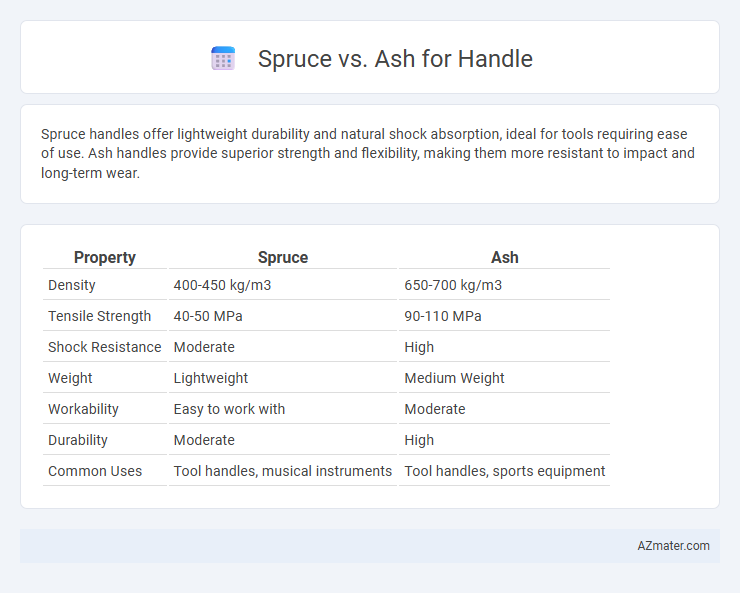Spruce handles offer lightweight durability and natural shock absorption, ideal for tools requiring ease of use. Ash handles provide superior strength and flexibility, making them more resistant to impact and long-term wear.
Table of Comparison
| Property | Spruce | Ash |
|---|---|---|
| Density | 400-450 kg/m3 | 650-700 kg/m3 |
| Tensile Strength | 40-50 MPa | 90-110 MPa |
| Shock Resistance | Moderate | High |
| Weight | Lightweight | Medium Weight |
| Workability | Easy to work with | Moderate |
| Durability | Moderate | High |
| Common Uses | Tool handles, musical instruments | Tool handles, sports equipment |
Introduction to Spruce and Ash Handles
Spruce handles are lightweight, providing excellent shock absorption and a smooth grip, making them ideal for tools requiring precision and comfort. Ash handles are renowned for their durability and strength, offering superior resistance to impact and wear, which ensures longevity in heavy-duty applications. Both woods are favored in tool handle manufacturing due to their unique combination of flexibility and toughness, catering to different user needs.
Physical Properties Comparison
Spruce handles are lightweight with moderate strength and good shock absorption, making them suitable for tools requiring flexibility and comfort. Ash handles offer higher density and superior toughness, providing excellent durability and resistance to impact, ideal for heavy-duty usage. The choice depends on the balance between weight and strength needed for specific tool performance.
Weight and Balance Differences
Spruce handles tend to be lighter, providing excellent maneuverability and ease of use in tools and sports equipment. Ash handles offer superior balance with a slightly heavier weight, enhancing control and durability during impact. Choosing between spruce and ash depends on whether you prioritize lightweight agility or robust balance for your specific application.
Durability and Lifespan
Spruce handles offer moderate durability and a lightweight feel, making them suitable for applications with less intense wear. Ash handles are renowned for their superior strength, shock resistance, and longer lifespan, often preferred for heavy-duty tools requiring extended durability. The dense grain structure of ash significantly enhances impact absorption, resulting in a more robust and resilient handle compared to spruce.
Shock Absorption Qualities
Spruce handles provide superior shock absorption due to their lightweight and flexible grain structure, reducing user fatigue during extended use. Ash handles are known for their high strength and moderate shock absorption, offering durability but transferring more vibration to the hand. For applications requiring maximum shock dampening, spruce is generally preferred over ash.
Workability and Ease of Shaping
Spruce offers excellent workability with a lightweight and soft texture that makes it easy to shape, sand, and carve for handle construction. Ash, while denser and heavier, provides superior strength and shock resistance but may require more effort to shape due to its coarser grain. Both woods have good workability, but spruce excels in ease of shaping while ash delivers enhanced durability for demanding handle applications.
Cost and Availability
Spruce handles are generally more affordable than ash, making them a cost-effective choice for budget-conscious projects. Spruce is widely available due to its rapid growth and common use in construction, ensuring steady supply in most markets. Ash handles, while slightly more expensive, offer greater durability and strength but may have limited availability depending on regional timber resources.
Common Applications in Tool Handles
Spruce handles are commonly used in tool applications requiring lightweight and moderately durable materials, such as in garden rakes, small hammers, and lightweight mallets, due to their good shock absorption and flexibility. Ash handles are preferred for heavy-duty tools like axes, sledgehammers, and baseball bats, offering superior strength, impact resistance, and durability under high stress conditions. Both woods provide excellent grip and vibration dampening, but ash's denser grain structure makes it ideal for tools subjected to rigorous, repetitive use.
Pros and Cons of Spruce Handles
Spruce handles offer lightweight properties and excellent shock absorption, making them ideal for tool handles used in tasks requiring precision and reduced user fatigue. However, spruce is less durable than ash and more prone to denting, which can lead to a shorter lifespan under heavy use. Its softness also means it may require more frequent replacement in high-impact applications compared to the sturdier ash handles.
Pros and Cons of Ash Handles
Ash handles offer superior shock absorption and durability, making them ideal for tools and sports equipment that require strength and resilience. Their natural grain pattern provides a comfortable grip with excellent tactile feedback, but ash is heavier compared to spruce, which may lead to increased fatigue during extended use. While ash resists splintering and wear better than spruce, it is generally more expensive and less flexible, potentially limiting its application in lightweight or highly flexible handle designs.

Infographic: Spruce vs Ash for Handle
 azmater.com
azmater.com